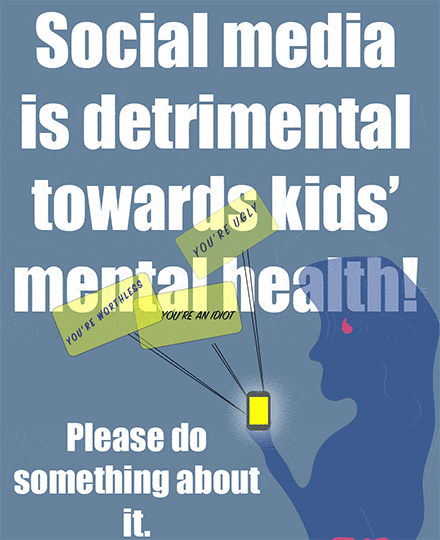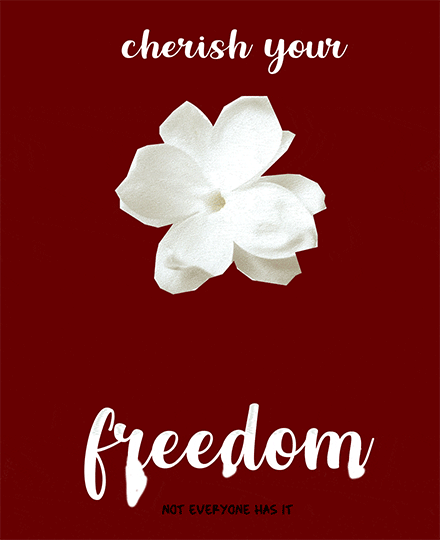“Harmful Effects of Social Media” – Eliza Cohen Interviewed by Estella Pinto
Eliza Cohen is a sophomore in the College of Arts and Sciences studying Psychology with a minor in Consumer Psychology and Hispanic Studies. Originally from Los Angeles, Eliza is a member of Sparks Dance Company, MUSE Marketing, Tamid Group, Annenberg Council, Penn Fashion Week, and is the founder of a sustainability club. Estella Pinto

Estella Pinto The basis of your poster is that social media is detrimental towards mental health. What made you pick this topic? How do you think it is harmful?
Eliza Cohen I had recently written a paper discussing this topic and I learned so much from the topic. I realized there is so much information out there about how social media is detrimental towards mental health, but that not a lot of people know about the harmful effects of social media and screen time, so I decided to create a poster protesting this!
Social media can be harmful towards kids but I think the most harmful effect is what it does to kids’ opinions about the way they look. Social media causes kids to constantly be viewing unrealistic, perfect pictures of what people look like and it therefore forces them to reassess the way they look, and because every little blemish on their face may not be perfect they may begin to view themselves in a negative light and begin to think that every aspect of their image is ugly.
EP Do you yourself use social media regularly? How do you think it affects you?
EC I would say that I do spend a good amount of time on social media, Instagram specifically, but I hate it. Lol. I feel like the way people portray themselves online is so different from the way they are and look in person and I do not like it. You also can spend hours online and I do not like wasting my time scrolling aimlessly on Instagram, but somehow end up doing it anyway. I am not sure why or what causes me to go on it, but I have been trying lately to spend less and less time on Instagram.
EP What was the motivation behind using social media as the subject of your poster? Is the toxicity of social media something you feel passionately about?
EC The motivation behind using social media as the subject of my poster was that I related so deeply to the idea after writing a research paper on the topic and wanted to get the issue out to the world because I believe it is a crucial issue in our society, and people need to know about it. Am I passionate about the toxicity of social media? No. But do I feel like it is definitely an issue that needs to be raised, addressed, and discussed more? 100%.
EP Walk me through the graphics of your poster. How do your poster’s animations reflect the message?
EC I decided to pick a person crying because she is receiving hateful comments on a picture she recently posted. The speech bubbles refer to the hateful comments. I decided to pick these comments and have the speech bubbles move around to mimic the idea that these bubbles are the thoughts that are active in the person’s mind, and that they are the comments she is constantly thinking about. The tear drops refer to her crying, and I decided to pick pink as the color to make them stand out. I decided to pick a blue for the girl and the background to have a melancholy undertone to the entire poster. I had the words in white written in large letters to have them interact with the rest of the poster. I decided to have the phone screen animated by lighting up to represent the idea that every time the phone lights up this person is receiving another hateful comment.
EP Your poster requests a solution to the harmful effects of social media on children. What do you think can be done to address this?
EC One idea I had to find a solution to the harmful effects of social media on children was that social media should implement more restrictions on their social media platforms which will prevent kids from having the ability to access each platform at such a young age.
EP Your poster specifically names children as victims of social media. Do you think social media is harmful to both children and adults to the same extent? Why did you specifically address children?
EC I do think that social media is harmful towards children and adults to the same extent, as there are many commonalities with respect to the harmful effects of social media, like the issues of fomo, body image, and more between children and adults. I specifically chose children because my research for my research paper was based on children, so I had recently learned more about kids with regards to this issue
“Mustang” – Estella Pinto Interviewed by Eliza Cohen
Estella is a junior in the College of Arts and Sciences double majoring in Economics and
Systems Science, and minoring in Math. She is from the DC metropolitan area. In her free time
she plays club soccer and is a member of the criminal justice reform organization, the Terrance
Lewis Liberation Foundation. Eliza Cohen

Eliza Cohen What inspired you to decide to select this movie?
Estella Pinto Mustang is one of my favorite movies. It has a very strong message about sisterhood, freedom, and adolescence that I find to be very moving.
EC What from this movie made you select your protest?
EP The movie follows five sisters who lose their freedom when their uncle becomes their guardian. The sisters are placed on house arrest and are taught traditional values and manners in an attempt to marry them off to respectable men. Throughout the film, we are shown their multiple attempts at rebellion and their ongoing humor, highlighting the excitement of youth and depression resulting from a lack of freedom or choice of destiny. I selected the idea for my poster from the sisters’ lack of freedom.
EC What made you decide to select these specific colors? Do they have some significance with regards to the movie or the protest?
EP I used the white to portray the innocence of the girls. Innocence is a major theme in the film as the uncle suppresses the girls in an attempt to protect their innocence and their family name and reputation in keeping with traditional cultural beliefs. The deep red is meant to represent the depression and bloodshed that ensued as a result of this suppression.
EC Why did you decide to animate the letters and the flower?
EP The dripping animation on the letters is meant to represent the bloodshed as previously mentioned, and also the time passing that the girls spent locked in their house, unable to leave. The dropping flower petal is also supposed to represent the loss of innocence as well as time moving slowly while they are stuck inside.
EC What do you think these animations add to your piece? Do they make the piece easier to understand, or more difficult because it allows for more interpretation of why each object is animated?
EP I think that the animations make the piece easier to understand. The slow dropping of the petal paired with the drooping on the letters present a melancholic feeling that allows an enhanced interpretation of the meaning and story behind my poster.
EC Do you think that a lot of people do not “cherish their freedom?”
EP I think that it is easy to forget how fortunate we are just to be able to do simple things like leave our house, or go to the beach, or wear whatever we want. Especially living in a western country as a woman, I think that it is important to remember that female repression is still very much present and common throughout the world.
EC Do you think there are other parts of the movie that could be turned into another piece of protest art?
EP The film is full of different themes that allow for critiques on traditional values, so I think that one could find a lot of different ways to turn the movie into protest art.